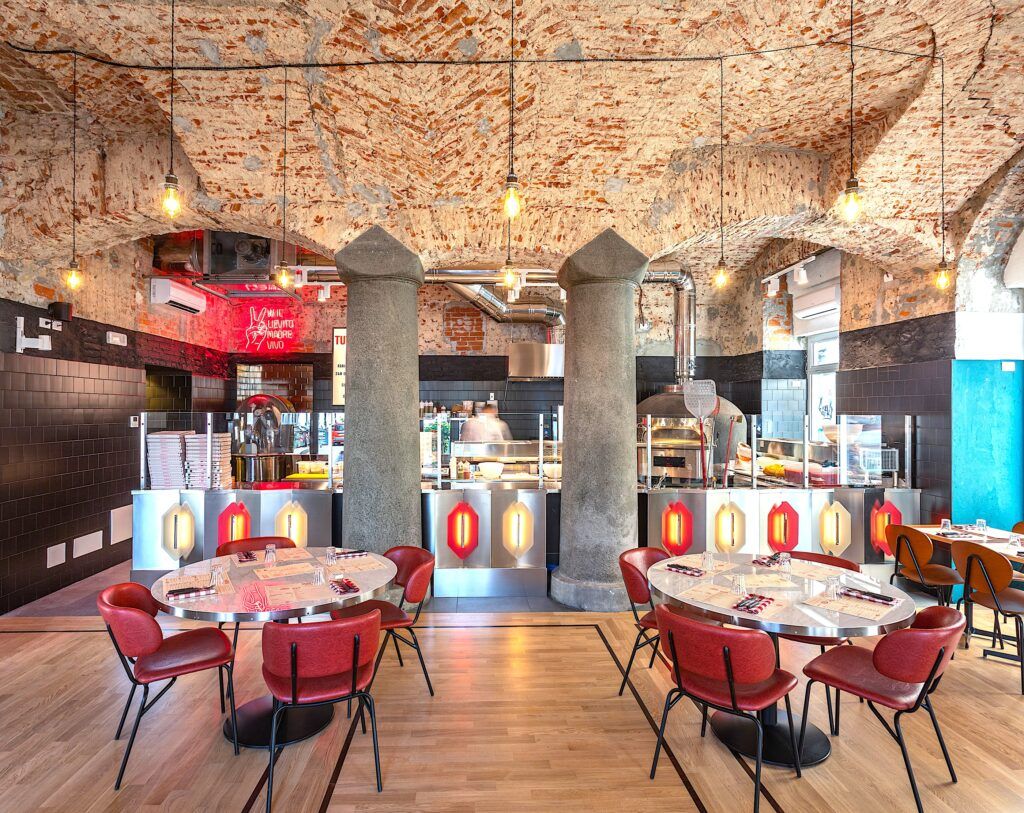The location
The restaurant is located in via Bellezia 24, between Piazza della Repubblica and piazza Emanuele Filiberto, where the largest open market in Europe is held. The building that houses the restaurant is part of the third Baroque extension of the historic district of Porta Palazzo, which faithfully resumed the Juvarrian design of the north-west part throughout the 18th century.
In the last twenty years, a long process of urban regeneration and decentralization of Turin’s nightlife has transformed the area into one of the liveliest and most animated districts of the city. Here every Saturday, since 1985, the Balôn has been organized, the famous flea, vintage and collectibles market, recognized as a real city institution.
The project
The project is the result of the union of two previously separate buildings, developed over 3 floors. An effective structural intervention, through a process by subtraction, involved the elimination of all the stairs present, creating a single vertical connection, in order to define unique and airy environments, more suitable for the use of a restaurant.
The main hall
The main hall is accessible from the road from via Bellezia and via Delle Tre Galline. The complex brick vaulted ceiling and the two black granite columns, which had previously been covered with plasterboard, have been brought to light. The walls, also in period bricks, have been colored with white and blue water-based paint. This chromatic personalization will constitute the main element of continuity with respect to the bar room, accessible from Piazza Emanuele Filiberto and reached by going down three steps.
As in the other premises of the Berberè brand, our fruitful collaboration with the communication agency continues
Comunicattive Agency, with which the colors and furnishings are carefully chosen. All the original neon lights, the signs, the hangers and the choice of murals are their conception and design, which in this case, as in other premises of the group, have been entrusted to the visual artists TO/LET.
Pizza cooking area cladding
Once the space to be allocated to the preparation and cooking of the pizza had been defined, the historical architectural importance conferred on the room by the two columns and brick vaults made it difficult to compare with classic cladding solutions.
No material would have been able to stand comparison with the visual impact of this prestigious environment: it was therefore decided to go in full contrast, designing a flashy and playful object.
The front of the kitchen is transformed into a playful single body with a great visual impact, which manages to keep the same steel as the kitchen surfaces, with the addition of backlit colored Bakelite hexagons.
A game that recalls fun atmospheres of the past, evoking the colors and lights of amusement parks, pinball machines and juke boxes.
Floors
Materials, geometries and colors of the ground finishes help to define the spaces and functions of the project areas. Thanks to the careful planning of the laying patterns, starting from easily acquired contemporary materials the effects of ancient flooring have been created.
The kitchen
The kitchen area, as well as the bar and the key places of the operations of the group’s restaurants, are designed together with the Berberè staff.
The large oven, the center of the kitchen, is in direct contact with both the pizza beating area and the filling area and together make up the main preparation area. No less important is the kneading area with the large mixer with dipping arms and everything needed for preparation. In this particular case, both rooms overlook and are visible from the administration room, guaranteeing two interesting focuses for the public.
The bar
The bar in this project is a front service bar dedicated to drinks, which recalls solutions from pizzerias of yesteryear. The refrigerators are built into a Tanganyika walnut wood cabinet, with glossy transparent varnish applied and a yellowish aging effect, which creates a recognizable 1950s effect, also thanks to the combination with an ad hoc rebuilt flooring.
The upper floor room
The main element of the upper floor is the circular hole surrounded by a railing. Remains of the old spiral staircase, built to keep the memory and create a bond of memory with the original state of the building.
It has the architectural function of connecting the two levels, to illuminate the rooms more, especially with the light of sunset, given the positioning of the windows to the west.
To emphasize this light, a boiserie with mirrors was designed that recalls a tailor’s atelier.
The murals by the visual artists TO/LET recall the same subject as on the floor below but turn chromatically towards yellow, helping to give an autonomous but recognizable personality to this new environment.

